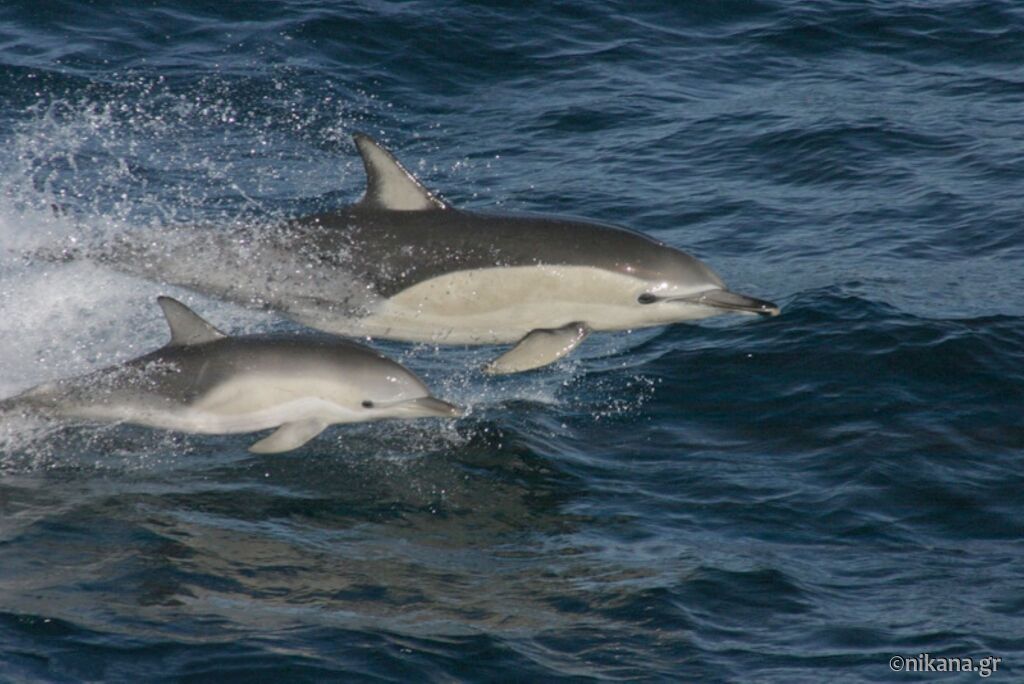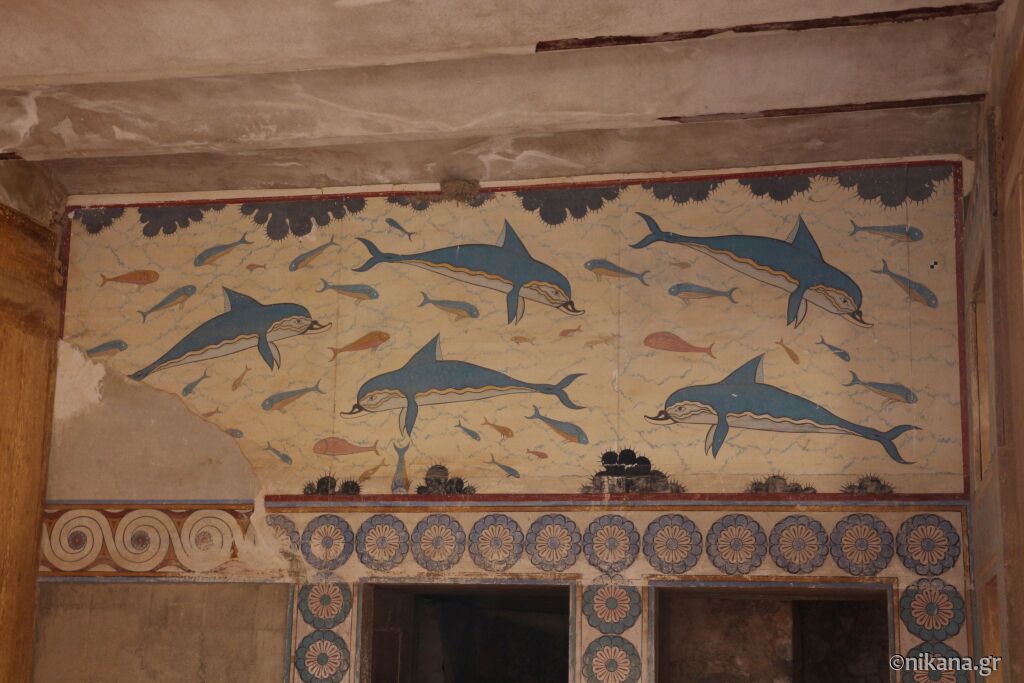Dolphins – Masters of the Blue Sea and National Symbol of Greece
Every summer we receive footage or photographs of dolphins from our guests and followers, which they see in the blue sea near the coast where they are vacationing. Both children and adults are excited to see them. These joyful animals hold a special place in all of us but also in the life of the Greeks from ancient times to today.
Through this text, we wanted to introduce you to the types of dolphins in Greek waters, their role in mythology, and their significance since ancient times. This text can also be useful for you to share with your little ones while on vacation in Greece.
What types of dolphins can be seen in Greece?
In Greece, there are 4 types of dolphins, with the most common being the common dolphin, which has been depicted on vases, reliefs, and paintings since ancient times, hence it was chosen as the national symbol of Greece. The types of dolphins are:
- Common Dolphin (Delphinus delphis) - the national symbol of Greece, and besides them, in Greece, you can also see
- striped dolphin (Stenella coeruleoalba),
- bottlenose dolphin (Tursiops truncatus), and
- risso’s dolphin (Grampus griseus).
Common dolphins are the most numerous species and number around 6 million worldwide. The number of common dolphins in the Mediterranean Sea is around 20,000, and there are several tens of thousands in the Black Sea.
Dolphins are born with a length of about one meter and a weight of approximately 10 kilograms.
During their lifetime, dolphins develop significantly, so females reach up to 2.4 meters and weigh about 150 kilograms, while males reach a length of 2.6 meters and a weight of 160 kilograms.
The sexual maturity of dolphins varies depending on the species and habitat. In the Pacific, dolphins usually become sexually mature between 7 and 9 years of age, while in the Mediterranean this period is extended to 12 years.
These mammals can live an average of between 55 and 60 years.
Pregnancy in dolphins lasts approximately 10 to 12 months
It is important to know that common dolphins are a protected species
Although the global population of common dolphins is around 6 million, the Mediterranean population is at risk due to pollution and hunting.
Common dolphins are protected by international agreements such as ACCOBAMS and ASCOBANS, which support the conservation of small whales and dolphins in European and global seas.
What can we teach the youngest about common dolphins?
How does a dolphin look, and what about the common dolphin, which is a symbol of Greece?
The dolphin has an elongated body and large fins. It is very fast in the water and can leap out of the sea, spinning around its axis, which we can often see. They are so fast that they frequently race boats and swim in front of them.
Their body is dark gray, while their bellies are usually cream or white. On the sides (flanks), they have various patterns that help us recognize them.
The common dolphin has distinctive creamy-yellow markings on its sides (flanks). The back, tail, and fins are dark gray, while the belly is light cream in color.
In contrast, striped dolphins have stripes that run from their snout to their tail, and their bellies are lighter in color. They do not have patterns on their sides.
Did you know that orcas are also dolphins? They are much larger than the common dolphin; in fact, they are the largest species of dolphin and share characteristics with other dolphins. However, they are a bit scarier, which is why they are called “killer whales” (due to their size).
Where do they live?
Common dolphins love both warm and cold seas. Some dolphins stay near the shore where the water is shallower, while others enjoy the depths, where the seabed is uneven and interesting, with underwater hills and slopes, where no one bothers them.
What do they eat?
Dolphins love various types of fish and squid. They are excellent hunters and enjoy diving into schools of fish. They are great divers, able to dive deep, even up to 200 meters. This helps them reach food that lives deeper in the water.
Do they live alone?
Common dolphins enjoy company and often move in large groups. They can live in pods with hundreds, even thousands of dolphins. Sometimes, huge groups of over 10,000 dolphins are formed, resembling a sea of dolphins!
Do dolphins communicate with each other?
Yes, dolphins communicate among themselves and even have names. Dolphins have their special whistles - these are their names by which they recognize each other. Calves, young dolphins, learn their whistle during the first year of life.
What does a baby dolphin look like?
When born, a baby dolphin is about 70 centimeters to 1 meter long and weighs around 10 kilograms. They are very cute and small, but grow quickly!
Unique community in the Corinthian Gulf
The Corinthian Gulf is unique in that it is the only place in the world where a mixed community of dolphins lives - common, striped, and Risso’s dolphins. Sometimes, up to 60 dolphins from all three species gather in a pod. This community provides rare opportunities for observation for scientists and tourists alike.
Dolphins in Greek mythology
Dolphins in Greek mythology had deep symbolic significance, representing the connection between humans and gods, as well as the mystical power of the sea. Here are a few key legends and myths that have given dolphins a special place in Greek culture and art.
1. Dolphins and Apollo
One of the oldest stories about dolphins is the one that connects the god Apollo with the dolphin. According to Homer’s “Hymn to Apollo,” in the myth of the founding of the oracle at Delphi, Apollo appears as a dolphin to guide a group of priests to the sacred place. Apollo, as the god of light and prophecy, by transforming into a dolphin, showed his power over nature and communication with the world beyond human understanding. This makes him the protector of Delphi, and the dolphin becomes his sacred symbol. Another name for Apollo is Delphinios (Δελφίνιος), meaning “lord of Delphi” but also “the one who has a connection with the dolphin.”
2. Poseidon\, the god of the sea\, and dolphins
Dolphins were associated with Poseidon, the god of the sea, and played a role in the story of his marriage to Amphitrite, a sea nymph. When Amphitrite fled from Poseidon, a dolphin found her and persuaded her to marry him. In gratitude, Poseidon placed the dolphin in the sky as the constellation Delphinus, which we recognize today as an official constellation. This shows how valued dolphins were and how the Greeks considered them protectors and helpers of the gods.
3. The myth of the poet Arion
Arion from Methymna on Lesbos, a famous poet and musician, was known for his music that could calm even animals. According to legend, during a voyage by ship, the sailors tried to kill him and rob him. Arion asked them to allow him to play his lyre one last time before they threw him into the sea. His music attracted dolphins, and when he jumped into the water, one of the dolphins carried him on its back and took him to shore. Herodotus recorded this story in his writings, making it one of the oldest records of love between humans and dolphins. Note: it is because of his poetry and instrument that lyric poetry is named.
4. Dionysus and the pirates
Another fascinating story involves Dionysus, the god of wine, joy, and ecstasy. According to the Homeric Hymns, pirates captured Dionysus, but when they realized his divine power, they panicked. Dionysus turned the pirates into dolphins, giving them a new form, freeing them from their mistakes, and allowing them to start a new life as friends of the sea. This story is both an allegory of transformation and the importance of dolphins in the story of divine grace.
5. Dolphins as symbols of protection for sailors and seafarers
In ancient Greece, dolphins were considered guardians and protectors of sailors, who believed that dolphins protected ships and kept them safe from danger. It was known that dolphins swam around ships, which sailors considered a sign of luck and protection. Therefore, they were often depicted on Greek vases, murals, and reliefs. The Greeks believed that the presence of dolphins on a journey was a lucky sign and that dolphins would safely guide them through the sea.
6. Punishments for killing dolphins in Ancient Greece
Although we have not been able to find direct evidence, it is still said in Greece that there was a death penalty for anyone who killed a dolphin in Ancient Greece. A large number of indirect pieces of evidence point to the truth of this claim, as dolphins were considered sacred animals due to their connection with the gods, and by harming them, one directly offended the gods.
Depictions of dolphins in art and religion
Dolphins often appeared in art. In the frescoes at Knossos, the Minoan civilization depicted dolphins as part of the marine landscape, indicating their importance in rituals and everyday life. Dolphins were portrayed as mediators between worlds, guarding the secrets of the sea and carrying the spirit of harmony. In many depictions and sculptures, dolphins surrounded the god of the sea Poseidon, reminding us of their role as his companions and helpers.
Watch the video of dolphins taken at Klimataria Beach or the video of dolphins filmed near Mount Athos here: Dolphins near Mount Athos.
If you are lucky enough to see dolphins during your vacation in Greece, share your experiences and footage with us.
We are always here to help you explore Greece! Follow us for the latest information, useful tips and authentic experiences to spend an unforgettable vacation in Greece!
We offer over 3,000 accommodations. Choose the right one for you and your family HERE.
Follow us on social networks where we regularly share exclusive offers, discounts and special arrangements for vacations in Greece as well as information, advice and useful news.
Facebook:Nikana.gr
Instagram: @nikana.gr
Tiktok: nikana.gr
Facebook grupa: Live from Greece
YouTube kanal @NikanaTravel
Write to us at e-mail: nikana@nikana.gr
Our site nikana.gr is the leading source of information about Greece.











Post a Comment
NOTE
All your questions in the comments will receive an answer via email so check your inbox shortly after you posted comment. For more detailed questions and responses, contact us via mail nikana@nikana.gr.